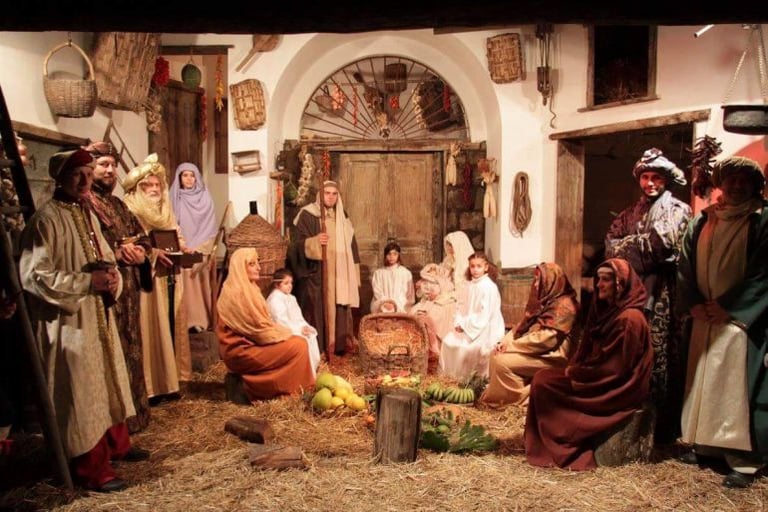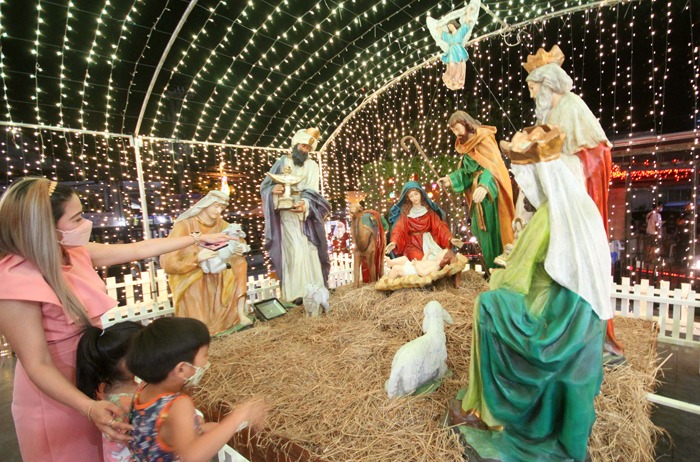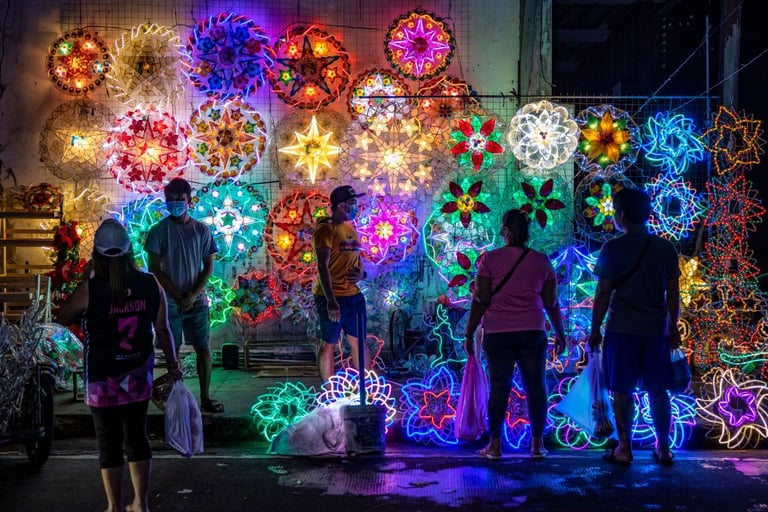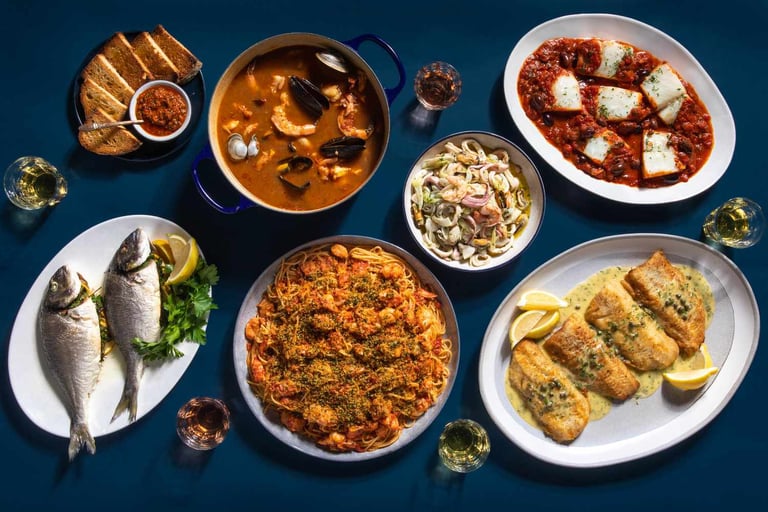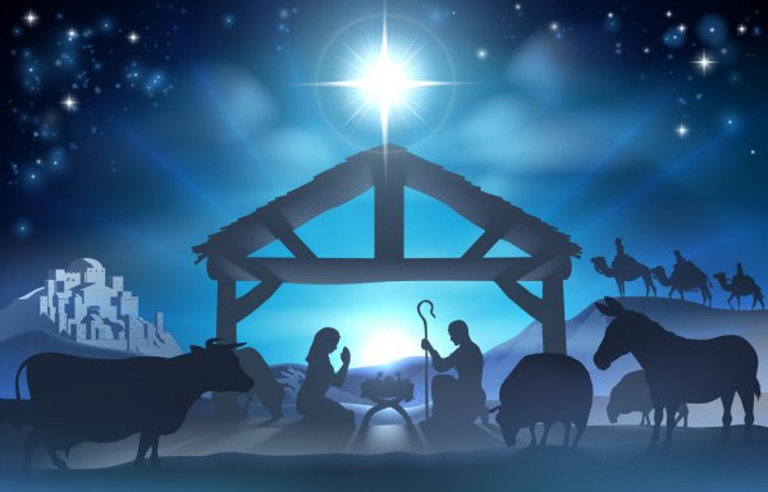Exploring Global Nativity Traditions: Unique Ways Cultures Celebrate
Discover how various cultures around the world celebrate the Nativity of Jesus. Explore unique customs, traditions, and festivities that honor the birth of Christ across the globe.
Grace Callahan
2/17/202515 min read
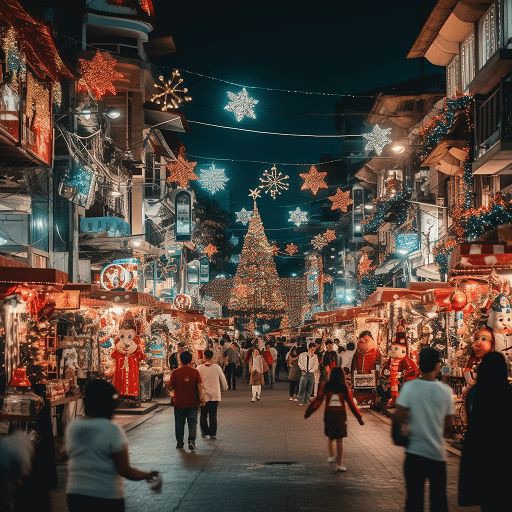

Ever wondered how different countries honor the birth of Jesus? Find out now!
Introduction:
The story of Jesus' birth is a rich tapestry of traditions and celebrations that span the globe. While the core message of Christmas focuses on the arrival of the Savior, cultures express this joy in distinct and creative ways. From vibrant parades to intricate Nativity scenes, each tradition tells its own story of faith and festivity. This article will explore some of the most unique Nativity traditions from around the world, showcasing the beautiful diversity within the Christian faith.
The Tradition of Nativity Scenes Around the World
Nativity scenes are not just a tradition within Christianity; they have become a global cultural expression of the story of Jesus’ birth. Across the world, different countries and cultures have put their unique stamp on how they portray the Nativity, using local customs, art, and materials. Let’s explore how this tradition has evolved in different parts of the world.
The Origin of Nativity Scenes: St. Francis of Assisi
The history of the Nativity scene traces back to St. Francis of Assisi, who is credited with creating the first live Nativity in 1223 in Greccio, Italy. Inspired by the desire to bring the Nativity story to life, he wanted to recreate the humble birth of Jesus in a way that ordinary people could truly feel.
St. Francis’ live Nativity scene included real animals, a manger, and human actors, bringing the story of the birth of Christ into the hearts of the faithful in a deeply personal way. His initiative inspired communities across Europe to create their own versions of the scene.
Over time, these live Nativity scenes evolved into static displays of the birth of Jesus, with figurines and intricate designs capturing the moment in homes, churches, and public squares.
Italy and the Presepe: The Iconic Neapolitan Style
In Italy, the tradition of the Presepe (Italian for Nativity scene) dates back to the 13th century, with Neapolitan style scenes becoming especially famous.
The Neapolitan Presepe is known for its exceptional detail and the inclusion of a wide variety of figures, not just the Holy Family, but also common townspeople, animals, and landscapes that reflect 18th-century life in Naples.
These scenes often include artisan-crafted figurines dressed in period costumes, representing the everyday life of the time. The beauty of the Presepe lies in the attention to detail: tiny pottery jugs, baskets of food, and even tiny cooking scenes bring the Nativity story to life in a way that connects the holy with the everyday.
The Neapolitan Presepe has been recognized as an art form, with families carefully assembling their scenes over days, often adding new figures year after year.
Spain’s Belén Tradition
In Spain, the tradition of crafting Belénes (Nativity scenes) is an important part of Christmas celebrations. While Belénes can be seen in homes and public squares, they are often intricate and larger than life, featuring hundreds of figures.
Crafting a Belén is a beloved activity, with intricate attention to landscape details and historical accuracy. Many Spaniards include not only the Holy Family but also shepherds, animals, angels, and even villagers—creating a living village around the scene.
Public Belénes in Spain are famous, with cities like Madrid and Seville hosting enormous outdoor displays. Some of the most famous Belénes can span several meters and feature moving parts, creating an interactive, dynamic Nativity scene.
Latin America’s ‘Nacimiento’: Vibrant and Interactive
In Latin America, the tradition of the Nacimiento (Nativity scene) takes on a particularly vibrant and interactive form, influenced by both indigenous traditions and Christian symbolism.
Nacimiento scenes in Mexico and Central America often feature brightly colored figures and culturally relevant additions such as local animals, native people, and scenes of daily life that tie the Nativity story into the local culture.
In many parts of Latin America, families and communities go all out in their decorating and building of Nacimientos, with interactive elements such as moving parts or lighting effects that enhance the festive atmosphere.
Particularly during Christmas Eve, it is common for families to gather around their Nacimientos, adding a new figure each day of Advent, creating a growing nativity story that culminates on Christmas Eve with the arrival of Baby Jesus.
From St. Francis’ humble beginning to the elaborate scenes crafted in homes and public squares around the world, Nativity scenes have become a symbol of the global celebration of Christmas. Whether through the exquisite detail of Italy’s Presepe, the intricate craftsmanship of Spain’s Belén, or the vibrant energy of Latin American Nacimientos, these scenes connect Christians and non-Christians alike to the deeper meaning of Christmas.
Christmas Processions and Parades in Nativity Celebrations
Across the world, Christmas is not just a time for private reflection and family gatherings; it is also a time for public celebrations that bring communities together in a shared expression of joy and reverence for the birth of Christ. In many countries, processions and parades are a central part of the festivities, often reenacting key scenes from the Nativity story or celebrating the cultural significance of Christ’s birth. Let’s explore some of the most cherished Christmas processions from around the globe.
The Philippines – Simbang Gabi and the Parol
In the Philippines, the Christmas season begins with Simbang Gabi, a series of pre-dawn Masses held for nine days leading up to Christmas Eve. This tradition is deeply rooted in Filipino culture and is celebrated with great enthusiasm across the country.
One of the most notable aspects of Simbang Gabi is the Parol—a brightly colored star-shaped lantern made from bamboo and paper that symbolizes the Star of Bethlehem, guiding the way to the birthplace of Jesus. During the processions, people carry Parols to illuminate the night, creating a stunning spectacle of light and color.
In many areas, the Parol has become a symbol of Filipino identity, and large Parol-making contests are held, further deepening the connection to the story of the Nativity.
Mexico’s Las Posadas
In Mexico, Las Posadas is a beloved Christmas tradition that takes the form of a reenactment of Mary and Joseph’s search for shelter before the birth of Jesus. The tradition typically takes place over nine nights, from December 16 to 24, and involves a procession of people traveling from house to house, singing carols and asking for shelter, just as Mary and Joseph did in Bethlehem.
Las Posadas symbolizes the journey of Mary and Joseph and is a way for communities to come together in solidarity, reminding everyone of the humble circumstances of Christ’s birth.
At the end of the procession, those participating are welcomed into the home with food, drinks, and sometimes piñatas, representing the joy and celebration of Christ's birth. Las Posadas serves as both a religious and social event, bringing the community closer together as they await Christmas.
Italy’s La Cavalcata dei Re Magi
In Italy, particularly in Rome, the Cavalcata dei Re Magi (The Three Kings Procession) is a centuries-old tradition that takes place on Epiphany, January 6th, which marks the arrival of the Wise Men to Bethlehem.
The procession involves participants dressing up as the Magi and traveling through the streets of Rome, recreating the journey of the Three Kings as they bring their gifts of gold, frankincense, and myrrh to the newborn Jesus.
This procession has historical roots in early Christian traditions and remains a vibrant way of celebrating the significance of the Epiphany. The parade includes musicians, dancers, and animals, creating a festive and dramatic atmosphere that highlights the importance of the Magi’s visit in the Nativity story.
Greece – The Kalanda Carols
In Greece, the Christmas season is filled with the sounds of Kalanda carols, which are sung by children as they go from house to house, spreading joy and celebrating Christ's birth.
The practice of Kalanda dates back to ancient times and has been adapted into the Greek Orthodox tradition as part of the Christmas festivities. Children carry small drums or triangles and sing traditional carols in exchange for treats or small gifts.
These carolers often start their rounds on Christmas Eve and continue through New Year’s Day, making the Kalanda a prominent feature of the holiday season in Greek communities. The carols themselves are often thematic, reflecting the joy and reverence associated with the Nativity.
From the Simbang Gabi lantern processions in the Philippines to the Kalanda carols in Greece, Christmas processions and parades serve as vital expressions of cultural and spiritual life, reminding people of the divine significance of Christ’s birth. These festive celebrations are a way for communities to unite in joy and reverence, passing down important stories, values, and traditions to future generations while keeping the true spirit of Christmas alive.
Nativity Food Traditions and Feasts
Food plays a central role in Christmas celebrations around the world, with many cultures featuring traditional feasts and special meals that hold deep symbolic meaning. These meals often reflect the spiritual significance of Christ’s birth, with dishes that honor Catholic traditions, cultural heritage, and family bonds. Let's explore some of the most beloved Nativity food traditions from different corners of the globe.
Italy’s Feast of the Seven Fishes
In Italy, the Feast of the Seven Fishes (La Vigilia or Christmas Eve dinner) is a beloved tradition, particularly among Catholic families. This festive meal is held on the night before Christmas and features an abundance of seafood dishes, often served in multiple courses.
The tradition stems from the Catholic practice of abstinence from meat on Christmas Eve, replaced by fish and other seafood. The number seven is symbolic, representing the seven sacraments of the Church, or in some cases, the seven days of creation in the Bible.
Dishes such as baccalà (salted cod), fried shrimp, clam chowder, and calamari are commonly served, each contributing to a communal experience that brings family and friends together. The feast emphasizes abundance and hospitality, reflecting the joy of Christ’s birth.
Poland’s Wigilia Dinner
In Poland, the Wigilia dinner, held on Christmas Eve, is one of the most important family traditions. The meal features twelve courses, each one symbolizing a different aspect of the Nativity story or the Christian faith.
The twelve courses often include dishes like barszcz (beet soup), pierogi (dumplings), carp, and compote of dried fruit, with each course representing the twelve Apostles or the months of the year. In addition to the symbolic significance of the dishes, a key element of the meal is the sharing of opłatek, a thin wafer that guests break and share with one another, symbolizing peace and unity.
A place setting is always left empty for an unexpected guest, reflecting the humble nature of Christ's birth and the hospitality extended to all. The Wigilia meal is a time for reflection, prayer, and togetherness before the arrival of Christmas Day.
Ethiopia’s Genna Feast
For Ethiopian Orthodox Christians, Christmas is celebrated on January 7th with a feast known as Genna. Leading up to the holiday, many Ethiopians engage in a period of fasting as a way of preparing for the sacred feast.
The Genna feast features traditional Ethiopian dishes, with the centerpiece often being doro wat, a rich chicken stew flavored with berbere spices, served with injera (a sourdough flatbread) that is used to scoop up the food. The meal also includes lentils, vegetables, and steamed bread.
The feast is often enjoyed with family and friends, marking the end of the fast and celebrating the birth of Christ. It’s a time for joyous reunions, prayer, and reflection on the significance of the Nativity in the Ethiopian Orthodox tradition.
France’s Réveillon
In France, the Réveillon refers to the late-night meal following Midnight Mass on Christmas Eve. This festive gathering is an important part of French Christmas traditions, particularly in regions like Provence and Alsace.
The Réveillon meal typically includes rich and indulgent dishes, such as foie gras, roast meats, oysters, and salmon, as well as desserts like buche de Noël (a traditional Yule log-shaped cake made of sponge cake and buttercream).
In some regions, the Réveillon extends for several hours, with guests enjoying wine, conversation, and festive music. This meal is a way to celebrate both the birth of Christ and the joyous atmosphere of the season. It’s an expression of hospitality, family unity, and religious reverence.
From Italy's Feast of the Seven Fishes to France's Réveillon, these holiday feasts offer much more than just delicious food—they provide a way for families and communities to come together, honor their religious traditions, and share in the joyous celebration of Christ’s birth. Whether through symbolic dishes, communal meals, or time spent together, Nativity food traditions remain an integral part of Christmas celebrations around the world.
Nativity Celebrations in Asia and the Middle East
Nativity celebrations in Asia and the Middle East showcase a blend of Christian traditions and local cultural practices. From India’s vibrant celebrations to Lebanon’s traditional feasts, these regions bring unique flavors to the celebration of Christ’s birth. Let's explore how Christmas and the Nativity story are commemorated in these diverse regions.
India’s Christmas Celebrations
In India, Christmas is a joyous and vibrant celebration, especially among the Christian communities, with elaborate Nativity scenes (called crèches) displayed in homes, churches, and public spaces. These scenes often feature not only the traditional Nativity figures—Mary, Joseph, the baby Jesus, the shepherds, and the Magi—but also local cultural elements such as Indian animals, flowers, and sometimes even miniature representations of Indian villages.
Midnight Mass is a central tradition, where families gather at churches for a special Christmas service that includes singing carols and prayers. In rural areas, processions are held with members of the community singing Christmas hymns as they make their way to the church.
In the southern states like Kerala, the Christmas celebrations are particularly grand, with feasts, traditional dances, and a focus on giving to those in need. The blending of Indian traditions with Christian customs reflects the rich diversity of Christianity in India.
Lebanon’s Traditional Christmas Feast
In Lebanon, Christmas is a deeply cherished occasion, with family being at the heart of the celebration. The Nativity is marked by church services, where families come together to attend Midnight Mass. Following the Mass, the Christmas feast takes center stage.
A traditional Lebanese Christmas meal includes a wide variety of regional dishes, such as kibbeh (meat-filled wheat patties), tabbouleh (a fresh parsley salad), stuffed grape leaves, and roast lamb or chicken. The meal often culminates in sweet treats like baklava, ma’amoul (shortbread filled with dates or nuts), and rice pudding.
Family gatherings are marked by lively conversation, traditional Arabic music, and an atmosphere of warmth and hospitality. In the Christian communities of Lebanon, decorating homes with Nativity scenes and Christmas trees is a key part of the holiday.
Sri Lanka’s Christmas Eve Traditions
In Sri Lanka, Christmas celebrations are a mix of Western Christian practices and local cultural elements. The night before Christmas, families gather for midnight Mass, followed by a festive meal. While the primary focus is on the Nativity and the birth of Jesus, Sri Lankan Christmas traditions include touches of local culture and customs.
The Christmas Eve service is an important time for reflection, with carol singing and hymns that recount the Nativity story. Churches are often adorned with bamboo Christmas trees, and families prepare their homes with Nativity decorations and lights.
The Christmas meal often includes dishes like rice and curry, roast meats, and traditional Sri Lankan desserts such as wattalappam (a spiced coconut pudding). Families also exchange gifts and celebrate with fireworks and lively music.
The Birth of Jesus in the Holy Land
The Holy Land, the birthplace of Jesus Christ, is the center of the world’s most significant Nativity celebrations. In Bethlehem, where Jesus was born, the Nativity story is commemorated with a profound sense of reverence and devotion. The Church of the Nativity, one of the oldest Christian churches in the world, becomes a pilgrimage site for thousands of Christians every year.
Christmas Eve is marked by a Midnight Mass held at the Church of the Nativity, where the faithful gather to commemorate Christ’s birth in the very place where it happened. The service includes carols, prayers, and a re-enactment of the Nativity.
In Bethlehem, Nativity displays are often set up in the town square, and many people visit local caves where the traditional Nativity is believed to have occurred. Local customs include sharing meals with family and generosity toward the less fortunate, reflecting the humble birth of Jesus.
Processions also play a major role in the Holy Land's Nativity celebrations, with the Latin Patriarch leading a procession to the Church of the Nativity to celebrate Christ’s birth. The nativity-themed rituals and the presence of pilgrims from all over the world add to the spiritual significance of the celebration.
From India’s vibrant Nativity displays to Lebanon’s rich feasts and the sacred traditions of Bethlehem, Nativity celebrations across Asia and the Middle East reflect the diversity and spiritual depth of the Christmas story. These celebrations beautifully combine local customs, family traditions, and the universal message of peace, joy, and humility that the birth of Christ brings to the world.
Unique Nativity Traditions in Africa
Africa's Nativity celebrations reflect the rich diversity of cultures, customs, and communities across the continent. From Ghana's lively Christmas celebrations to South Africa’s Christmas picnics in the summer sun, each region brings its own unique blend of local and Christian traditions to the celebration of Christ’s birth. Let’s explore how Christmas and the Nativity story are celebrated in different African nations.
Ghana’s Christmas Celebrations
In Ghana, Christmas is a joyous occasion that brings together family, friends, and communities. The celebration often begins with church services on Christmas Eve, followed by festive meals and dancing well into the night.
Music plays a major role in the Christmas celebration, with traditional gospel music, drumming, and dancing filling the air. Church choirs sing Christmas carols, blending Christian hymns with local Ghanaian rhythms.
Community and family are central to Ghanaian Christmas traditions, with open houses and feasts shared among neighbors. Traditional Ghanaian dishes like jollof rice, fufu, goat meat, and fried plantains are prepared for the festive meal. There is a strong sense of togetherness, with families coming together to celebrate the Nativity with joy and generosity.
Nativity scenes are often displayed in homes and churches, symbolizing the humble birth of Jesus. Many people also engage in charity by giving to those in need during the season of goodwill.
Kenya’s Christmas Mass and Celebrations
In Kenya, Christmas is a religious and community-oriented celebration, with a focus on church services and family gatherings. The Nativity story is celebrated through prayers, hymns, and Midnight Mass on Christmas Eve.
The Christmas Mass is one of the most important events, where families come together in churches, many of which are packed with worshippers. The services include carol singing, readings from the Bible, and reenactments of the Nativity story. The festive spirit continues with family gatherings, where large meals are shared.
Kenyan Christmas foods like roast meats, chapati, rice, and vegetables are served, along with sweet treats like fruit cakes and baked goods. It’s a time for reunion and celebration with extended family and close friends.
In rural areas, Christmas may also involve community celebrations with traditional dances, songs, and local Christmas plays that share the Nativity story in a way that resonates with local culture.
Nigeria’s Christmas in the Village
In Nigeria, Christmas is a time for family reunions and community celebrations, especially in the villages. Here, Christmas blends Christian traditions with local culture, creating a unique and vibrant atmosphere.
The Nativity story is marked by church services, where families attend Midnight Mass, and carol singing is a major part of the festivities. In villages, it is common to see Nativity scenes set up in homes, churches, and public spaces.
Christmas in the village involves large family gatherings, where traditional Nigerian foods like jollof rice, pounded yam, goat meat, and pepper soup are prepared. Families often exchange gifts, and children look forward to new clothes and special treats.
In some regions, local Christmas parades or Nativity plays are held, incorporating traditional music, dance, and storytelling to celebrate the birth of Jesus in ways that resonate with Nigerian culture.
South Africa’s Christmas Traditions
In South Africa, Christmas falls during the summer, and the season is marked by outdoor celebrations, picnics, and family gatherings. The Nativity story is central to the holiday, but the way it’s celebrated is influenced by the country’s warm weather and multicultural heritage.
Christmas is often celebrated with a church service in the morning, followed by a relaxed and festive day. Many South Africans enjoy Christmas picnics, especially in parks or at the beach, where they share barbecues or braais (a South African-style barbecue). Traditional South African dishes, like braaied meats, potjiekos (stew), and malva pudding, are popular at Christmas feasts.
Nativity scenes are set up in homes and churches, but the day itself is spent in the company of loved ones, with outdoor activities, carol singing, and children’s games. There is also a strong emphasis on giving, and many South Africans participate in charity events to help those less fortunate during the Christmas season.
In some regions, there are Christmas parades featuring traditional music, dancing, and theatrical performances that highlight the Nativity and celebrate Christ’s birth in a South African context.
From the community spirit in Ghana to the summer feasts in South Africa, Africa’s Nativity traditions reflect the diversity of its cultures and people. These unique celebrations highlight the universal themes of family, faith, and joy, while incorporating local customs and flavors that make each country’s Nativity celebration a memorable and vibrant expression of Christmas.
Conclusion:
The Nativity story is a universal one, transcending geographical boundaries and cultural differences. While the way people celebrate the birth of Jesus may vary across the globe, each tradition is a testament to the importance of this sacred event. Whether through intricate Nativity scenes, joyous processions, or festive meals, the global Nativity celebrations reflect the rich diversity of the Christian faith. As you explore these traditions, may you find inspiration in the ways people around the world honor the birth of Christ and carry the message of His love.
